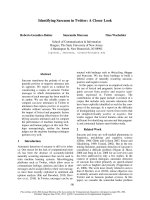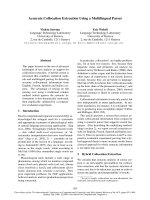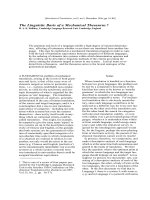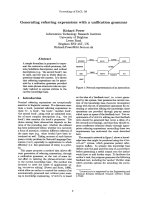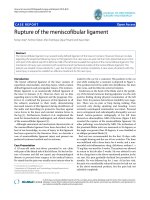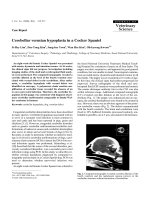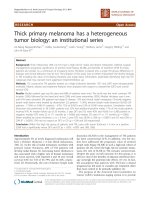báo cáo khoa học: "Alpha-fetoprotein-producing primary lung carcinoma: A case report" doc
Bạn đang xem bản rút gọn của tài liệu. Xem và tải ngay bản đầy đủ của tài liệu tại đây (1.1 MB, 4 trang )
CAS E REP O R T Open Access
Alpha-fetoprotein-producing primary lung
carcinoma: A case report
Masahiro Kitada
1*
, Keisuke Ozawa
1
, Kazuhiro Sato
1
, Yoshinari Matsuda
1
, Satoshi Hayashi
1
, Yoshihiko Tokusashi
2
,
Naoyuki Miyokawa
2
and Tadahiro Sasajima
1
Abstract
Alpha-fetoprotein (AFP)-producing lung adenocarcinoma is a rare type of lung cancer, with its characteristics not
yet fully clarified. We recently encountered a case of this type of lung cancer. The patient was a 69-year-old man
who consulted an internist with the chief complaint of epigastric pain. Chest X-ray and CT revealed a lobulated
mass measuring 70 mm in diameter in the right lower lung field and a metastasis in the right hilar lymph nodes.
Of the tumor markers, the serum AFP was elevated (4620 ng/ml), and the serum carcinoembryonic antigen and
carbohydrate antigen 19-9 were also slightly elevated. Transbronchial lung biopsy revealed the diagnosis of lung
cancer. Under thoracoscopic assistance, right lower lobectomy + mediastinal lymph node dissection was carried
out. Immunostaining showed the tumor cells to be AFP-positive. The tumor was thus diagnosed as an AFP-
producing lung adenocarcinoma. The patient followed an uneventful clinical course after the surgery, with serum
AFP decreasing to the normal range by about 2 weeks after the surgery. As of this writing, no sign of tumor
recurrence has been noted. This case is presented here with a review of the literature.
Background
Aalpha-fetoprotein (AF P) is a type of protein formed in
the fetal liver and yolk sac and is detected in the fetal
serum. In regard to the pathological significance of this
proteininadults,serumAFPisoftenelevatedin
patients with liver cancer or gonadal germ cell tumors,
such as yolk sac tumor. Because the serum AFP level
decreases in response to effective treatment, measure-
ment of the serum AFP level is carried out during fol-
low-up of patients after treatment or for the detection
of tumor recurrence. AFP-producing ovarian cancer and
gastric cancer have also been reported, whereas AFP-
producing liver cancer is rare. Because AFP-producing
lung cancer has scarcely been reported, the clinical fea-
tures of this type of lung cancer are still unclear. In this
context, we report a case of this t ype of cancer that we
encountered recently.
Case presentation
A 69-year-old man consulted a nearby internal medicine
clinic with the chief complaint of epigastric pain. He
was diagnosed as having gastroesophageal reflux and
initiatedontreatment.Achestx-rayperformedatthat
time revealed a mass in the right lower lung field. The
patient had a history of smoking (Brinkman index:
1800) and had been diagnosed earlier as having pulmon-
ary emphysema.
He had the past of the alcoholic hepati-
tis. His family history was not noteworthy. He was 160
cm tall and weighed 55 kg. Physical examination
revealed no abnormalities. A chest x-ray revealed a mass
measuring 65 mm in diameter in the right lower lung
field (Figure 1). Chest CT revealed a lobulated mass
measuring 65 mm in diameter involving S9 and S10 of
the right lung, as well as an enlarged right hilar lymph
node (Figure 2). Abdominal CT revealed no lesions in
the liver, gallbladder, or pancreas. FDG-PET revealed
uptake in the mass (SUV: 8.1) in the right lung and in
the swelling of #10 lymph node (SUV: 4.1). No abnor-
mal FDG accumulation was note d in any other organ.
Serum biochemical tests did not reveal any evidence of
hepatic dysfunction or hepatitis B or C. Of the tumor
markers, serum carbohydrate12-5(CA12-5),neuron-
specific enolase (NSE), Sialyl Lewis X (SLX), b-human
chorionic gonadotropin (bHCG), pro-gastrin releasing
peptide (PRO-GRF), and cytokeratin 19 fragment
(CYFRA) levels were within normal range, while the
* Correspondence:
1
Department of Surgery, Asahikawa Medical University, Japan
Full list of author information is available at the end of the article
Kitada et al. World Journal of Surgical Oncology 2011, 9:47
/>WORLD JOURNAL OF
SURGICAL ONCOLOGY
© 2011 Kitada et al; licensee BioMed Central Ltd. This is an Open Access article distributed under the terms of the Creative Commons
Attribution License ( which permits unrestricted use, distribution, and rep roduction in
any medium, provided the original work is prope rly cited.
serum AFP was markedly elevated (4620 ng/ml), and
serum carcinoembryonic antigen (CEA; 6.6 ng/ml) and
carbohydrate antigen 19-9 (CA19-9; 46.6 ng/ml) were
slightly elevated. Transbronchial l ung biopsy led to the
diagnosis of AFP-producing lung carcinoma. Surgic al
treatment w as selected on the basis of the preoperative
tumor stage (T2N0M0). Right lower lobectomy + med-
iastinal lymph node dissection excision was carried out
by video assisted thoracic surgery. The resected tumor
measured 6.5 cm in diameter and was a solid tumor
(Figure 3). Histopathologically, the tumor was composed
of tumor cells with relatively irregular nuclear sizes and
cylindrical, partially eosinophilic and dimly bright cell
bodies showing little polymorphism, leading to the diag-
nosis of moderately differentiated adenocarcinoma (p0,
pm0, ly1, v0). Lymph node metastasis was noted in #7,
#10 and #11i lymph no des, which led to a r evision of
thetumorstagetoT2bN2M0/stageⅢA. Immnohisto-
chemical st aining for AFP revealed positive staining of a
number of tumor cells for A FP, leading to the diagnosis
of AFP-producing lung adenocarcinoma (Figure 4, 5).
The cells also showed positive staining for cytokeratine
(CK)18, CK19, and anti-hepatocyte antibody. Thus,
although the histological and morphological features o f
the tumor differed from those of hepatocellular carci-
noma, the chr omatic responses of the tumor to immu-
nostaining were close to those known for hepatocytes.
Of the indicators of the tumor mal ignancy grade, tumor
protein 53 was negative, and the MIB-1 index was
slightly high (40%). The postoperative course was favor-
able, and the serum AFP level re turned to normal range
by about 2 weeks after the surgery. At present, the
Figure 2 Chest CT revealed a lobu lated mass measuring 65
mm in diameter involving S9 and S10 of the right lung
Figure 1 A chest x-ray revealed a mass measuring 65 mm in
diameter in the right lower lung field.
Figure 3 A macroscopic specimen showed that the resected
tumor measured 6.5 cm in diameter and was a solid tumor
Kitada et al. World Journal of Surgical Oncology 2011, 9:47
/>Page 2 of 4
patient is receiving adjuvant chemotherapy (Tegafur-
Uracil), and has not, until date, shown any signs of
tumor recurrence.
Conclusions
AFP is on e of the fetal proteins with a molecular weight
that is intermediate between that of albumin and a1-
globulin. It is produced by the fetal liver, yolk sac, and
gastrointestinal cells. In relation to its pathological sig-
nificance, serum AFP is useful as a tumor marker in
patients with live r cancer. In adults showing elevated
serum A FP levels, the malignant diseases requiring dif-
ferential diagnosis include liver cancer, germ cell tumors
(e.g., yolk sac tumor), and metastatic lung cancer, and
the benign diseases requiring differential diagnosis
include acute or chronic hepatitis, liver cirrhosis, and
congenital biliary atresia [1-3]. It has been reported that
AFP-producing tumors account for about 2 %-8% of all
cases of gastric cancer, and that the percentage is higher
among cases of advanced gastric cancer [4,5]. Only a
small number of reports have been published of cases
with AFP-producing lung cancer; therefore, the patho-
physiology and clinical characteristics of AFP-producing
lung cancer have not yet been adequately clarified.
AFP-producing lung cancer was first reported by Cor-
lin et al. [6] and has since been reported to account for
about 2% of all lung cancers [7]. Histologically, adeno-
carcinoma (often poorly differentiated adenocarcinoma)
accounts for the most of AFP-producing lung cancers.
Furthermore, la rge-cell carcinoma accounts for 25% of
all AFP-producing lung cancers. Thus, adenoc arcinoma
and l arge-ce ll carcinoma account for nearly all c ases of
AFP-producing l ung cancer [8], although rare cases of
AFP-producing squamous cell carcinoma [9] and AFP-
producing carcinoid [10] have also been reported. As
stated above, AFP-producing gastric cancer shows a
high propensity for metastasizing to the liver and lymph
nodes, and its prognosis is reported to be poorer as
compared with that of non-AFP-producing gastric can-
cer. In relatio n to AFP-producing lung cancer, it must
be kept in mind during the follow-up of these p atients
that the percentage of cases with poorly differentiated
adenocarcinoma and the frequency of a high MIB-1
index are significantly higher in these cases than in
those with non-AFP-producing liver cancer [11] during
the follow-up of patients.
In regard to tumor markers, cases of AFP-producing
liver cancer presenting with elevated serum CEA or
HCG levels have been reported [12]. In the present case
also, slight elevation of the serum CEA and CA19-9
levels was noted in addition to elevation of the serum
AFP. The serum levels of these tumor markers returned
to normal soon after tumor resection, and their patholo-
gical significance remained unknown.
The concept “ hepatoid carcinoma” has been proposed
in connection with this disease [13,14]. This concept is
used to indicate adenocarcinoma composed of a mixture
of hepatoid components (cancer assuming the form of a
hepatocellular carcinoma) and papillary components.
Cases of he patoid carcinoma affecting the pancreas, kid-
ney, duodenum, gallbladder, etc. have been reported.
Immunohistochemically, AFP is found in both the hepa-
toid component and the papillary component of hepa-
toid carcinomas. If the hepatoid component is
dominant, the term “ hep atoid-adenocarcinoma” is used.
When the tumor keratin expression profile was analyzed
in the present case, a very small percentage of the cells
were found t o be positive for CK7, whereas CK20 and
TIF-1 were negative, the profile thus differing slightly
from the profile known for typical lung cancer.
Figure 4 Histological findings of tumor showed pulmonary
adenocarcinoma (HE × 100)
Figure 5 Immnohistochemical findings showed that positive
staining of a number of tumor cells for AFP, leading to the
diagnosis of AFP-producing lung adenocarcinoma. (×100)
Kitada et al. World Journal of Surgical Oncology 2011, 9:47
/>Page 3 of 4
However, the tumor in our patient also di ffered from
hepatocellular carcinoma in terms of the histological
and morphological features, which eventually led to the
final diagnosis of AFP-producing lung adenocarcinoma.
The number of cases with this type of tumor reported
unti l date is rather small. Further accumulation of cases
and analysis of data o n the malignancy grade and long-
term prognosis of AFP-pro ducing lung adenocarcinoma
would be desirable.
Consent statement
Informed consent was obtained from the patient for
publication of this case report and accompanying
images. A copy of the written consent is available for
review by the Editor-in-Chief of this journal.
Author details
1
Department of Surgery, Asahikawa Medical University, Japan.
2
Department
of Clinical Pathology, Asahikawa Medical University. Japan.
Authors’ contributions
MK have operated this case and analyzed all data. KO, and KS, YM, SH did
the assistant of the operation. YT and NM diagnosed h the pathology of this
case. TS was the professor of the surgical science and had a guide. All
authors read and approved the final manuscript.
Competing interests
The authors declare that they have no competing interests.
Received: 27 February 2011 Accepted: 9 May 2011
Published: 9 May 2011
References
1. Bergstrand CGQ, Czar B: Raper electrophoresis study of human total
serum protein with demonstration of a new protein fraction. Scand j Clin
lab Invest 1957, 9:277-286.
2. Gitlin D, Perricelli A, Gitlin GM: Synthesis of arpha-fetoprotein by liver yolk
sac and Gastrointestinal tract of human conceptus. Cancer Res 1972,
32:979-982.
3. Etarinov YS: Content of embryo-apecific alpha-globlin in fetal and
neonatal sera and sera from adult humans with primary carcinoma of
the liver. Fed Proc Transl Suppl 1966, 25:344-346.
4. Adachi Y, Tsuchihashi J, Shiraishi N, Yasuda K, Etoh T, Kitano S: AEP-
producing gastric carcinomamultivariate analysis of prognostic factors in
270 patients. Oncology 2003, 21:357-362.
5. Chang YC, Nagasue N, Kohno H, Taniura H, Uchida M, Yamanoi A, Kimoto T,
Nakamura T: Clinicopathologic features and long-term results of arufa-
fetoprotein-producing gastric cancer. Am J Gastroenterol 1990,
85:1480-1485.
6. Corlin RF, Tompkins RK: Serum alpha-fetoglobulin in a patient with
hepatic metastasis from brobchogenic carcinoma. Am J Dig Dis 1972,
17:533-535.
7. Walop W, Chrétien M, Colman NC, Fraser RS, Gilbert F, Hidvegi RS,
Hutchinson T, Kelly B, Lis M, Spitzer WO: The use of biomarkers in the
prediction of survival in patients with pulmonary carcinoma. Cancer
1990, 65:2033-2046.
8. Okunaka T, Kato H, Konaka C, Yamamoto H, Furukawa K: Primary Lung
Cancer Producing Alpha-Fetoprotein. Ann Thorac Surg 1992, 53:151-152.
9. Asamura H, Nakayama H, Kondo H, Tsuchiya R, Ono R, Noguchi M, Yoda H,
Naruke T: AFP-producing squamous cell carcinoma of the lung in an
adolescent. Jpn J Clin Oncol 1996, 26:103-106.
10. Yamagata T, Yamagata Y, Nakanishi M, Matsunaga K, Minakata Y,
Ichinose M: A case of primary lung cancer producing alpha fetoprotein.
Can Respir J 2004, 11(7):504-506.
11. Hiroshima K, Iyoda A, Toyozaki T, Haga Y, Baba M, Fujisawa T, Ishikura H,
Ohwada H: Alpha-fetoprotein-producing lung carcinoma: Report of three
cases. Pathology International 2002, 52:46-53.
12. Yoshino I, Hayashi I, Yano T, Takai E, Mizutani K, Ichinose Y: Alpha
fetoprotein-producing adenocarcinoma of the lung. Lung Cancer 1996,
15:125-131.
13. Arnould L, Drouot F, Fargeot P, Bernard A, Foucher P, Collin F, Petrella T:
Hepatoid Adenocarcinoma of the lung Report of a case of an unusual
alpha fetoprotein-producing Lung Tumor. Am J Surg Pathol1 1997,
21:1113-1118.
14. Hayashi Y, Takanashi Y, Ohsawa H, Ishii H, Nakatani Y: Hepatoid
adenocarcinoma in the lung. Lung. Cancer 2002,
38:211-4.
doi:10.1186/1477-7819-9-47
Cite this article as: Kitada et al.: Alpha-fetoprotein-producing primary
lung carcinoma: A case report. World Journal of Surgical Oncology 2011
9:47.
Submit your next manuscript to BioMed Central
and take full advantage of:
• Convenient online submission
• Thorough peer review
• No space constraints or color figure charges
• Immediate publication on acceptance
• Inclusion in PubMed, CAS, Scopus and Google Scholar
• Research which is freely available for redistribution
Submit your manuscript at
www.biomedcentral.com/submit
Kitada et al. World Journal of Surgical Oncology 2011, 9:47
/>Page 4 of 4
